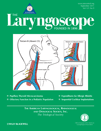Relevance of both individual risk factors and occupational exposure in cancer survival studies†
The Example of Intestinal Type Sinonasal Adenocarcinoma
This work was supported by grants from the Ligue Contre le Cancer, the Cancéropôle Ouest and the Nantes University Hospital (Recherche Clinique Department). The authors have no other funding, financial relationships, or conflicts of interest to disclose.
Abstract
Objectives/Hypothesis:
Wood dust is a well-established risk factor for intestinal type sinonasal adenocarcinoma. The 5-year overall survival has varied from 20% to 80% according T1-T4 stages; 5-year survival according to histologic subtype has varied from 20% to 50%.
To date, no study has evaluated whether environmental, occupational, and personal risk factors have any impact on both overall and cancer-specific survival. We aimed to determine whether exposure to carcinogenic risk factors besides wood exposure can influence the survival of patients with sinonasal ethmoid carcinoma.
Study Design:
Retrospective cohort study of the association of survival data and occupational and personal carcinogenic risk factors.
Methods:
All patients hospitalized for ethmoid adenocarcinoma at the Nantes University Hospital between 1988 and 2004 were included . Data concerning TNM classification, histology, type and quality of tumor resection at the macro- and microscopic level, and occupational and personal exposure to carcinogens were collected. Statistical analysis was conducted using univariate and multivariate linear regression.
Results:
A total of 98 patients were included with a response rate of 98%. Data showed 86% of patients had been exposed to wood dust. The 5-year survival was 62%. We first identified four factors that independently influenced overall survival: diplopia (P = .0159), spread to the orbit (P = .0113), bilateral involvement (P = .0134), TNM stage (P < .001). When the analysis included all occupational environmental factors (wood dust, solvent, and metals exposure) as well as personal risk factors, the length of exposure to metals (P = .0307) and tobacco exposure (P = .0031) also were found to influence 5-year overall survival. We identified high prevalence of colon cancer (4%) and double cancer (18%).
Conclusions:
We showed exposure to both environmental (tobacco) and occupational (metal dust) factors could influence survival in the diagnosis of a cancer. Our study suggests that screening for colon cancer should be offered to wood dust workers. A prospective multicentric study should be necessary to confirm our results.




